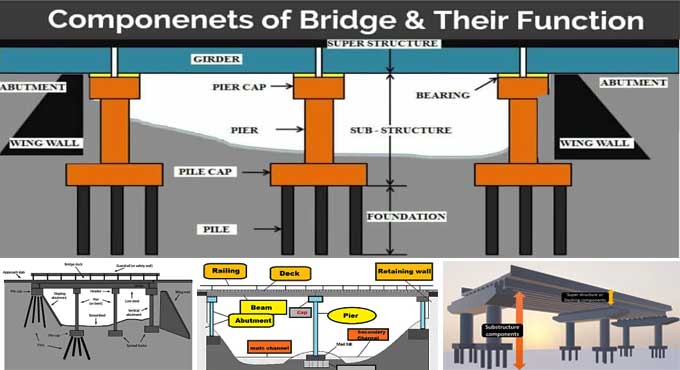
An overview of the bridge's components and their functions
Basically, a bridge is a way to cross a deep gorge or obstacle, such as a river, canal, road, or railroad, by way of a system that transports road traffic or sometimes other moving loads over it.
The first bridges were always constructed across tiny waterways using simply wood planks or downed trees in antiquity. The Style Bridge suspension was afterwards built using twisted creepers that were attached to the tree branches on each side of the canyon.
Engineering has undergone a rigorous and complete evolution since it first began with rope and chain footbridges. It is one of the greatest achievements of humankind's engineering ingenuity.
Bridge Components and Their Functions
Generally, there are three general components of bridge construction:
- Adjoining Structure
- Superstructure
- Substructure
Adjoining Structure
Adjoining structures usually involve two major components which are:
- Approaches
- Guard Stones
Approaches: Building it at the start or end of any bridge is a common practice. Its primary purpose is to make bridge entrances and departures smooth and easy.
Guard Stones: Often used to protect a corner of a street or the side of a gate, they are commonly used to restrict transportation to a specific lane or occasionally as road railings.
Bridge?s Superstructure components
The components of the superstructure of a bridge are as follows:
1. Trusses: Trusses are bridge elements created by joining triangular pieces to divide loads and bend moments across the bridge. Cantilevers, suspension, and simple trusses are further kinds. The distribution surface of the truss network can be created as a deck truss, a pony truss, or a truss. The way traffic moves across the bridge is different on every other truss.
2. Girders: Girders are also bridge components that expand across the pile caps and connect them together. Decking is protected by girders, which are often connected to beams. Depending on how long the bridge is, there can be a single span or even more than one span connecting all the bends.
3. Arches: The bridge with the arches is moving with a lot of force. The stability and load-bearing capacity of the bridge may be monitored via the arches. The number of arches and the materials used during construction is both quite significant.
4. Decks: The road or rail surface of the bridge is known as the deck, a bridge component. The girders or large beams that support the decks are shielded from damage by the piers. A deep foundation, mostly piles and a cap system support the entire building.
5. Barriers: component barriers of the bridge are Bridges including walls on the sides of their decks, mostly as a safety and security feature. For better aesthetics, they might be concrete walls, chains, rails, or specially made fittings.
Bridge?s Substructure components
The components of the substructure of a bridge are as follows:
1. Foundation: The foundation of bridges is really important. Strata and piers are supported by foundations, which passively return loads to the strata and radiate loads to piers and buttresses.
Deep foundations are established for bridge structures to prevent scouring due to water flow or to reduce the chance of weakening.
2. Pile: Typically, piles are set to provide the initial base and sustain the bridge. The piles provide the bridge with a stable and sturdy foundation by distributing the weight and strain of the bridge uniformly throughout the soil.
Numerous factors, including the state of the soil, the volatility of the soil, and the maximum load-carrying capability, affect the material and battery arrangement. When it comes to river crossings, scouring is sometimes necessary even before the bridge is built.
3. Bents: They are known as bents because of the way the stacks and caps are arranged. The substructure's foundation is made up of many bends.
4. Pile Caps: A pile cap provides additional load transfer power to the stacks. Due to their placement at the top of pile bases, these are also called pile caps. Bridge caps are also made from concrete to provide maximum protection for the roof.
5. Piers: The piers are vertical bridge framework elements that sustain the deck or perhaps provide the bearings needed to transport loads to the subsurface soil via the foundation. At intermediate phases, these systems serve as reinforcement for bridge spans.
To get more details, watch the following video tutorial.
Video Source: VinCivil World
There are two major objectives of the pier structure:
- The foundation is moved with the loads.
- Latitudinal force resistance.
Each pier is built to bear vertical loads on its own. It is advised that the pier be constructed for lateral loads as well in earthquake-prone areas.
Concrete is used to construct a few of the piers. So little steel has been utilised thus far in the construction of the pier. It is said that current pier construction technology uses composite columns or steel columns filled with concrete.

6. Pier Caps: Bridge headstocks are one of the components that make up pier caps. A bridge's superstructure components which split the load evenly among all the piers can pass loads on bearings through this space.

